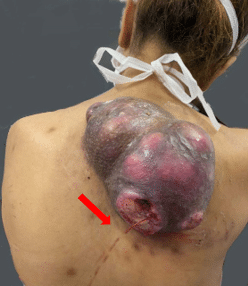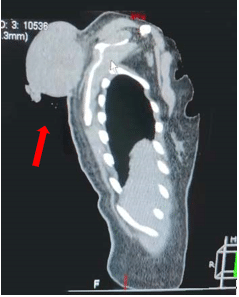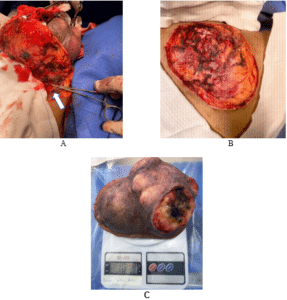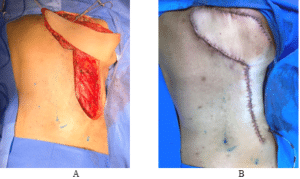Garritano C1*, Carvalho TA2, Oliveira M2, Cruz LM2, Penedo LD2, Costa MWCF2, Rodrigues MR3
1General Surgery. Department of General Surgery of the Federal University of the State of Rio de Janeiro, Brazil
2General Surgery Resident, Gaffrée and Guinle University Hospital, of the Federal University of the State of Rio de Janeiro, Brazil
3Medical Student, Federal University of the State of Rio de Janeiro, Brazil
*Correspondence author: Garritano C, MD, Ph.D of General Surgery, Department of General Surgery of the Federal University of the State of Rio de Janeiro, Brazil; Email: [email protected]
Published On: 19-02-2023
Copyright© 2023 by Garritano C, et al. All rights reserved. This is an open access article distributed under the terms of the Creative Commons Attribution License, which permits unrestricted use, distribution and reproduction in any medium, provided the original author and source are credited.
Abstract
Sebaceous gland carcinoma is a rare and aggressive tumor that accounts for less than 1% of all cutaneous malignancies. It is classified as intraocular and extraocular and is rarely found in the chest wall. Imaging tests such as Computed Tomography and Magnetic Resonance help to identify the location, size, and evaluation of the involvement of adjacent structures. The treatment is surgical excision, and diagnosis is confirmed postoperatively by the immunohistochemical analysis.
Keywords: Sebaceous Tumor; Cutaneous Malignant Tumor; Immunohistochemical Analysis
Introduction
Sebaceous carcinoma is a rare and aggressive skin cancer that originates from the adnexal epithelium of the sebaceous gland and corresponds to 0.2% to 4.6% of all cutaneous malignant tumors [1-6]. Although it can be found in any part of the body that has sebaceous glands, the periorbital region is the most affected (75%) [1,4,5,7].
Extraocular sebaceous carcinoma accounts for only 25% of cases and may affect the head, neck, external genitalia, extremities and trunk [1,4,7-9]. Without specific symptoms, the diagnosis is restricted to the immunohistochemical analysis, with the use of several markers, after biopsy or total resection of the lesion [1-3,5]. We present a case of carcinoma of sebaceous glands in the trunk, whose patient was slow to seek medical attention resulting in a giant tumor.
Case Report
Female patient, 42 years old, mentioned that 10 years prior a dorsal lesion had arisen, and drained itself. About two years later, several similar lesions appeared that spontaneously drained, leaving purulent secretion. Subsequently, there were episodes of improvement and worsening associated with continuous twinging and disabling pain, radiating to the upper limb, numbness in the right hand, itching, and strong burning. Then several lesions grouped, with centrifugal growth, which began to coalesce, with an increase in pus output and episodes of jet bleeding. It evolved with anorexia and fever. She sought care in an emergency hospital and was being medicated with antibiotics, anti-inflammatory, and analgesic drugs, but there was no improvement in the symptoms. In August 2022, she was referred to the General Surgery outpatient clinic for investigation and treatment of the lesion.
On physical examination, the patient was in regular general condition, pale, skinny, with dehydration and signs of emotional depression.
She presented a vegetative, ulcerated, multinodular lesion in the dorsal region, measuring 18x12x10 cm. The skin around it reacted like “orange peel” with spontaneous drainage of seropurulent and hematic content with episodes of “jet” bleeding, and association with burning and pruritus, both of low intensity, a decrease in local sensitivity, and disabling pain. There was no axillary, cervical, supra or infraclavicular lymphadenopathy (Fig. 1).

Figure 1: Carcinoma of the sebaceous gland in the posterior chest wall presenting bleeding (red arrow).
The patient was hospitalized because of local hemorrhage during the incisional biopsy. The result of the histopathological examination was a tumor of the sebaceous glands. Computed Tomography (CT) with contrast was performed, and the heterogeneous lobulated formation was evidenced in the dorsal subcutaneous of the median/paramedian thoracic transition on the right, with peripheral calcification foci, and heterogeneous enhancement. In the evaluation of orthopedics, radiology, and neurology services, scapular involvement was not observed (Fig. 2).

Figure 2: CT shows a large soft-density tissue tumor in the dorsal region.
Laboratory tests showed severe anemia (hemoglobin of 7.4 mg/dL), alteration of liver and canalicular enzymes, and hypokalemia (2.97 mg/dL), with alterations corresponding to the Electrocardiogram (ECG). A transfusion packed red blood cells and potassium replacement was done. She also presented hypercalcemia (Ca=20 mg/dl), which lead immediately to the use of zoledronic acid at a dose of 4 mg/5 ml, diluted in 100 ml of saline solution intravenously for about 15 minutes for 3 days, associated with urinary output monitoring, and venous hydration. With the reduction of hypercalcemia (Ca=13.8 mg/dl), the patient was referred for surgical treatment, which included the participation of the Neurosurgery and Plastic Surgery team.
The tumor was completely removed. There was no muscle invasion, the spinal nerve was preserved, and as a precaution, only a small fragment of the trapezoid muscle was removed (Fig. 3).

Figure 3: A: Spinal nerve preserved (white arrow); B: Tumor removed; C: Surgical specimen (17x13x8,9 cm-1,019 Kg/2,2465 lb).
Plastic surgery was performed, reconstructing the posterior chest wall through the myocutaneous flap with the right latissimus dorsi (Fig. 4).


Figure 4: Posterior chest wall reconstruction.
After surgery, the patient reported muscle pain, cramp, and Chvostek and Trousseau signs characterizing significant hypocalcemia (Ca=7.9 mg/dl) necessities use 10% calcium gluconate at the dose of 3 ampoules/day/2 days, intravenously, for a rapid recovery of calcium levels. Next, the use of calcium carbonate 2 g was recommended orally to maintain normal calcium levels.
The patient had a satisfactory evolution, obtaining hospital discharge in good clinical condition, and being under outpatient control since august 2022 until now.
The histopathological result was Carcinoma of sebaceous glands. The neoplasm is ulcerated and infiltrates the subcutaneous tissue. Free surgical edges. Immunohistochemical study showed EMA positive and CEA negative.
Discussion
Sebaceous carcinoma was first described by Allaire in 189110 and since there is little information about this type of tumor, only in 2005 did the World Health Organization start to consider it a carcinoma, and it was then listed by the American Joint Committee on Cancer as a non-melanoma and not Merkel cells skin tumor [11].
Sebaceous carcinoma is part of the group of Malignant Adnexal Tumors of the Skin (MATS) and it is a rare and aggressive tumor that accounts for less than 1% of all cutaneous tumors, but even despite that, it is the most common type among cutaneous adnexal tumors [3,7,12-13].
About 25% of its cases are extraocular and are generally located on the head and neck, although references are pointing that the following are also possible locations for the disease: parotid, breast, ovary, prostate, trunk, and extremities [2,4,7,9,12,14].
In a retrospective study in the Surveillance, Epidemiology and End Results (SEER) database conducted in the USA from 1988 to 2006, with 4032 MATS, only 16.8% were identified in the trunk and only 7.4% exhibited lymph node metastases [4].
This same study shows that the incidence of extraocular sebaceous carcinoma was 0.06/100,000 people per year, with a tendency to increase in the elderly and in men [4].
A population-based study of the SEER-18 database from 1975 to 2016, also with MATS, shows an incidence of sebaceous carcinoma of 18/million persons, with a median age of 73 years old, higher in males (59.1%) and Caucasians (85.7%0) [15]. Several publications corroborate these data, although some references indicate that there is no difference between both sexes, while others claim to be more common in elderly women [2,7,9,13,16-18].
The main risk factors are UV and ionizing radiation, preexisting scars, xeroderma pigmentosa, immunosuppression, prior radiotherapy, organ transplantation, lymphoma, changes in repair genes (which may also be present in Lynch syndrome), HIV and HPV infection after brachytherapy and Asian ethnicity [1,2,9,11,13,16,17].
A nonspecific clinical presentation and the presence of a painless nodular skin lesion, often involving the subcutaneous tissues, of yellowish or orange color due to lipids excess which may ulcerate or bleed does not make us immediately think of a sebaceous gland tumor [1,5,7,12,16].
Our patient is a female, 42-year-old, presenting a tumor located in the posterior chest wall, and she had only referred to the previous existence of sebaceous cysts, which are not the most common types cited in the literature. She presented a multinodular lesion, painful, probably due to the size of the tumor, with ulceration and bleeding, and reddish color.
The use of imaging exams helped us find the location and size of the lesion as it also assisted in the evaluation of the involvement of nearby structures. In this patient, the tumor was restricted to subcutaneous tissue and did not invade the musculature.
The definitive diagnosis consisted of histopathological and immunohistochemical analysis of an incisional biopsy or total tumor removal, allowing a differential diagnosis with several benign and malignant tumors such as; epidermoid cyst, other adnexal tumors, and basal cell carcinoma cutaneous, B-cell lymphoma, and dermatofibrosarcoma [5,7,12,19].
We initially chose to perform the incisional biopsy and although the result of the histopathological examination was a probable tumor of sebaceous glands, and as the patient began to present bleeding in the lesion, we opted for hospitalization.
Preoperatively, in the laboratory tests was identified severe hypercalcemia. Hypercalcemia may be present in between 20% and 44.1% of patients with malignant neoplasms [20,21]. Several mechanisms explain hypercalcemia in the presence of malignant tumors, and the most common is the excessive production of PTHrP (Parathyroid Hormone-related Protein) [20,21].
Almost 50% of serum calcium is linked to albumin and therefore ionized calcium dosage is important in cases of malignancy. If this test is not available, the correction of the calcium value can be calculated using the formula: serum calcium + 0.8 x (4- patient’s albumin level); 4.0 is the normal albumin level in g/dL.
The options for treatment are hydration with saline solution, calcitonin, biphosphonate and corticosteroids, and if all fail, hemodialysis should be performed. In the present case, we chose to use an IV saline solution, a diuretic (furosemide), and second-generation bifosphphonate (zoledronic acid). The patient presented a satisfactory response to the treatment with the reduction of the calcium level and was referred for surgery.
The tumor was completely removed, there was no muscle involvement and the plastic surgery team performed the reconstruction of the posterior chest wall.
In the postoperative period, the patient presented symptoms and characteristic signs of hypocalcemia and a calcium replacement protocol was immediately performed with full recovery. The fact that the patient presented hypocalcemia after tumor removal confirms that hypercalcemia before surgery was associated with malignancy.
In the histopathological examination, the use of conventional hematoxylin and eosin staining may show positivity for the tumor of sebaceous glands, but the confirmation is made through the immunohistochemical analysis with the use of markers such as EMA (epithelial membrane antigen), BER-EP4, CA15.3, androgen receptor, and adipophilin [1,3,7]. A characteristic of this type of tumor is the negative result for CEA (Carcinoembryonic Antigen) [2].
In the presented case, the immunohistochemical analysis of the surgical specimen showed to be positive for EMA and negative for CEA, confirming the diagnosis of a sebaceous gland tumor.
Extraocular sebaceous carcinoma, in addition to presenting local recurrence between 9% and 36% of cases in the 5-year period, can also cause regional metastasis through lymph node involvement in 28% of cases and at a distance compromising the liver, lung, bones, brain and urinary tract in 21% of cases. The 5-year survival reaches 68% of cases [2-4,7].
The patient had a satisfactory evolution, obtaining hospital discharge in good clinical condition, and remains under follow-up by the General Surgery and Plastic Surgery Services since the procedure was performed in September 2022. The patient so far did not present a recurrence of the lesion, regional or distant metastasis.
Conclusion
Carcinoma of sebaceous glands is a rare, aggressive tumor, more common in the ocular region and very rare in the chest wall. The treatment is surgical and the definitive diagnosis is made by immunohistochemical examination, which highlights the positivity for EMA and negativity for the CEA.
Conflict of Interest
The authors have no conflict of interest to declare.
References
- Sekgololo JM, Chauke RF, Tshazi N. A rare giant extraocular, anterior chest wall sebaceous carcinoma. Int J Surg Case Rep. 2020;66:110-14.
- Raghuveer MN, Sr D, Thulasi V, Shenoy KM, Diwakar SR. Extraocular sebaceous carcinoma on the chest wall – a case report. J Clin Diagn Res. 2014;8(6):5-7.
- Torres JS, Amorim AC, Hercules FM, Kac BK. Giant extraocular sebaceous carcinoma: case report and a brief review of a literature. Dermatol Online J. 2012;18(11):7.
- Jaiswal LS, Neupane D, Lagegu N, Khadka S, Sah B, Pradhan A. Sebaceous carcinoma of trunk with bilateral axillary lymph node metastasis: a rare presentation of malignant adnexal tumor in young adult. J Surg Case Rep. 2022;2022(6):rjac280.
- Knackstedt T, Samie FH. Sebaceous Carcinoma: A review of the scientific literature. Curr Treat Options Oncol. 2017;18(8):47.
- Zada S, Lee BA. Sebaceous carcinoma. PathologyOutlines.com website [Last accessed on February 14, 2023] https://www.pathologyoutlines.com/topic/skintumornonmelanocyticsebaceouscarcinoma.html
- Gall R, Ortiz-Perez S. Sebaceous Gland Carcinoma. StatPearls Publishing. 2022.
- Stacey SK, Moss TA, Kobayashi TT. Sebaceous carcinoma on the arm of a 10-year-old girl. Dermatol Online J. 2017;23(6):13030.
- Ferreira I, Wiedemeyer K, Demetter P, Adams DJ, Arends MJ, Brenn T. Update on the pathology, genetics and somatic landscape of sebaceous tumours. Histopathology. 2020;76(5):640-9.
- Natarajan K, Rai R, Pillai SB. Extraocular sebaceous carcinoma: A rare case report. Indian Dermatol Online J. 2011;2(2):91-3.
- Soh CL, Moyle P, Scott-Blagrove J, Benson J. Corrigendum to Sebaceous carcinoma of the chest wall: A case report. Radiology Case Reports. 2021;16:1870-3.
- Kleibert M, Płachta I, Czarnecka AM, Spałek MJ, Szumera-Ciećkiewicz A, Rutkowski P. Treatment of malignant adnexal tumors of the skin: a 12-year perspective. Cancers. 2022;14(4):998.
- Wang F, Wang XY, Jiang X. Clinical features and prognosis of young and middle-aged adults with skin sebaceous adenocarcinoma. Dermatol Surg. 2022;48(8):797-801.
- Alves S, Silva F, Ferreira M, Cabral J. Atypical ‘benign behaviour’ of eyelid sebaceous carcinoma. BMJ Case Rep. 2012;2012:bcr2012006430.
- Goyal A, Marghitu T, Goyal N. Surgical management and lymph-node biopsy of rare malignant cutaneous adnexal carcinomas: a population-based analysis of 7591 patients. Arch Dermatol Res. 2021;313(8):623-32.
- Sargen MR, Starrett GJ, Engels EA, Cahoon EK, Tucker MA, Goldstein AM. Sebaceous carcinoma epidemiology and genetics: emerging concepts and clinical implications for screening, prevention, and treatment. Clin Cancer Res. 2021;27(2):389-93.
- Wu A, Rajak SN, Huilgol SC, James C, Selva D. Cutaneous sebaceous carcinoma. Australas J Dermatol. 2020;61(3):e283-92.
- Iglesias I, Troyano J, Díaz-Valle D, Genol I. Carcinoma De Glándulas Sebáceas: Presentación de Dos Casos Clínicos. Arch Soc Esp Oftalmol. 2008;83:445-8.
- Kyllo RL, Brady KL, Hurst EA. Sebaceous carcinoma: review of the literature. Dermatol Surg. 2015;41(1):1-15.
- Mirrakhimov AE. Hypercalcemia of Malignancy: An update on pathogenesis and management. N Am J Med Sci. 2015;7(11):483-93.
- Vakiti A, Anastasopoulou C, Mewawalla P. Malignancy-Related Hypercalcemia. [Last accessed on February 14, 2023] StatPearls Publishing; 2022. https://www.ncbi.nlm.nih.gov/books/NBK482423/
Article Type
Case Report
Publication History
Received On: 26-01-2023
Accepted On: 12-02-2023
Published On: 19-02-2023
Copyright© 2023 by Garritano C, et al. All rights reserved. This is an open access article distributed under the terms of the Creative Commons Attribution License, which permits unrestricted use, distribution, and reproduction in any medium, provided the original author and source are credited.
Citation: Garritano C, et al. A Rare Case of a Giant Tumor of Sebaceous Glands in the Posterior Chest Wall. J Surg Res Prac. 2023;4(1):1-7.

Figure 1: Carcinoma of the sebaceous gland in the posterior chest wall presenting bleeding (red arrow).

Figure 2: CT shows a large soft-density tissue tumor in the dorsal region.

Figure 3: A: Spinal nerve preserved (white arrow); B: Tumor removed; C: Surgical specimen (17x13x8,9 cm-1,019 Kg/2,2465 lb).


Figure 4: Posterior chest wall reconstruction.


